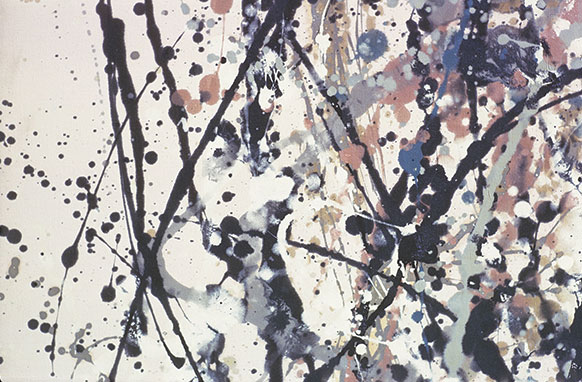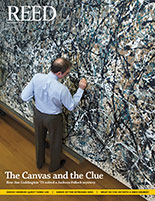
IRIS login | Reed College home Volume 92, No. 3: September 2013
Ariadne’s Thread

Prof. Charles Rhyne’s 1962 photo provided the crucial clue to the mystery of Jackson Pollock’s One: Number 31, 1950.
By Chris Lydgate’90
When Theseus returned from his bittersweet victory over the Minotaur, the Athenians were so overjoyed, according to Plutarch, that they preserved his galley in the harbor so that men would never forget his deeds. Whenever a plank on the ship decayed, the Athenians replaced it with a new, stronger one, which led Plutarch to an interesting philosophical conundrum. Could the vessel still be called the Ship of Theseus even if none of its original timbers were intact?
This paradox is no idle matter—it hovers over the shoulder of everyone who is entrusted with preserving, restoring, or reproducing a work of art. Does the essence of a painting lie in its pigments and its parchment, in the smudges of its vermilion and the cracks in its canvas? Or is a painting primarily a vehicle for conveying an idea? How far can you touch up a Rembrandt? What happens if you Xerox a Warhol? Is imperfection an essential quality of art?
These are the questions that confronted Jim Coddington ’74 and his team at MoMA as they embarked on the restoration of a monumental canvas by Jackson Pollock. As writer Christian Viveros-Faune explains in our cover story, when the project collided with a million-dollar headache—whether a portion of the canvas had actually been altered by someone else—Jim reached out to his Reed mentor, the late Prof. Charles Rhyne [art history 1960–97]. It was Rhyne who supplied the crucial clue.
The word “clue” is particularly fitting in this context, because it comes from the Old English cleowen, meaning a ball of thread or yarn, referring to the thread that Ariadne gave Theseus to guide him through the Labyrinth of Crete.
Sometimes we have the good fortune to meet people who help us thread our way through life’s maze of twisty passages. In my case, I found several influential guides at Reed. Often the most valuable things they gave me were not specific bits of instruction but clues in the Ariadnean sense—principles passed on from professor to student as partners in a collective enterprise.
This atmosphere of intellectual camaraderie is, I think, the direct result of a faculty dedicated to education in its most profound sense—not stockpiling facts but teaching students how to find their way in a world where the planks are always being replaced. That is one of Reed’s defining characteristics, and the reason why I find the story of the canvas so powerful.

LATEST COMMENTS
steve-jobs-1976 I knew Steve Jobs when he was on the second floor of Quincy. (Fall...
Utnapishtim - 2 weeks ago
Prof. Mason Drukman [political science 1964–70] This is gold, pure gold. God bless, Prof. Drukman.
puredog - 1 month ago
virginia-davis-1965 Such a good friend & compatriot in the day of Satyricon...
czarchasm - 4 months ago
John Peara Baba 1990 John died of a broken heart from losing his mom and then his...
kodachrome - 7 months ago
Carol Sawyer 1962 Who wrote this obit? I'm writing something about Carol Sawyer...
MsLaurie Pepper - 8 months ago
William W. Wissman MAT 1969 ...and THREE sisters. Sabra, the oldest, Mary, the middle, and...
riclf - 10 months ago